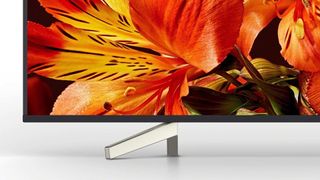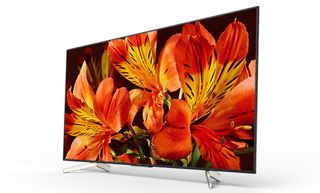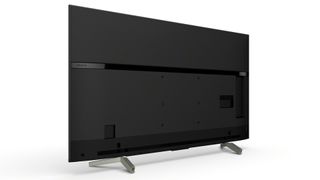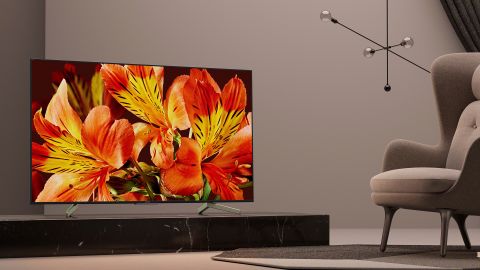TechRadar Verdict
Sony's XF850F series is cutely designed and relatively affordable for 4K, HDR-capable TVs. Unfortunately, though, that’s pretty much where the good news ends. The set’s use of an IPS type of LCD panel and edge LED lighting means it just can’t deliver the sort of contrast demanded by today’s high dynamic range pictures.
Pros
- +
Affordable 65-inch TV
- +
Tidy, cable-free design
- +
Decent picture processing
- +
Solid sound quality
Cons
- -
Poor contrast
- -
Android TV can annoy
- -
Inadequate HDR performance
- -
Picture issues
Why you can trust TechRadar
In the battle for the middle-tier television sets, Sony is clearly leading the pack.
Sony's XBR-X900E series from 2017 was one of the best mid-range screens for its price range last year, and now that the Japanese TV maker has brought the X1 Extreme processor into the range, it stands without a peer in 2018.
But what about those of us looking to move even further into value territory? For us, Sony has revamped its X850 series for 2018 - which so far includes a 65-, 75- and 85-inch iteration (the XBR-65X850F, XBR-75X850F and XBR-85X850F, respectively).
The X850F’s appeal is brutally simple: It’s designed to offer a taste of Sony’s often outstanding LCD TV picture quality to customers who can’t afford to step up to Sony’s excellent X900F, Z9D, A1E OLED and A8F OLED high-end models.
Unfortunately, though, while the X850F does deliver a bit of Sony’s picture magic courtesy of its X1 video processor, all the good work is ultimately undone by a single fundamental flaw: the use of an IPS panel.
Design
As you’re putting the 65X850F together for the first time - either hanging it on the wall or popping it onto its straightforward silver feet - you can’t help but notice that it feels much more plasticky in its build than Sony’s more expensive models do.
Fortunately, though, you don’t really notice the plasticky finish from a normal viewing distance. Instead, you’ll more likely be pleasantly surprised by the understated, minimalist elegance of the narrow black screen frame and the lack of any visible cabling thanks to cabling ‘channels’ built into the TV’s feet.
The one potential fly in the design ointment is the way the X850F’s two feet are positioned quite wide on the TV’s underside, meaning you’ll need a similarly wide piece of furniture to place the set on.
Design TL;DR: The X850F series aren’t the best built line of TVs we’ve ever seen, but they hide their plasticky finish quite nicely behind their crisp, minimalistic lines. Handily, they also hides all your cables, too.

Smart TV (Android TV)
The X850F is pretty challenged in the smarts department thanks to Sony’s ongoing love-in with Google’s Android TV platform. As well as persisting with the same clunky-looking, poorly organised full screen home menu we’ve had to put up with for generations now, Android TV seems to put so much strain on the TV’s available processing power that now everything - even including the TV’s set up menus - sometimes runs painfully slowly.
You also can’t customize the home screen as effectively as you can most other modern smart TV interfaces, and software updates to the system are frequent and, often, quite large.
There are a few positive things about the X850F’s smart TV features, though. For starters, it supports a huge number of apps and the Android TV platform now supports direct Chromecasting to the TV, as well as Google Assistant and Alexa voice recognition functionality.
Smart TV TL;DR: Android TV is as unhelpfully laid out, buggy and sluggish as ever. Only here it seems to have an even more detrimental effect than usual on the running speed of the TV’s set up menus.

HD/SDR Performance
As we’ll see later, the X850F is so flawed with HDR playback that we’d argue that it’s only really worth considering as a standard dynamic range television. But in truth, it’s far from perfect even with SDR’s limited light and color range.
The problem, basically, is that the type of LCD panel - known as IPS - the X850F uses just can’t deliver a convincing black level/contrast performance. The way IPS panels work means that dark scenes tend to look very grey and washed out - a problem which can also see subtle shadow details getting lost in the ‘mist’.
This is all especially true when, as with the X850F, an IPS panel is lit from its edges rather than directly from behind. And even more so when the edge lighting doesn’t have any local dimming to help it focus light only where it’s needed in a picture.
Even though SDR content requires much less brightness than high dynamic range content, the X850F struggles to deliver anything approaching a convincing black color during dark scenes on Blu-ray or DVD, leaving them looking flat and dull.
Not having very satisfying black levels also reduces the sense of vibrancy and dynamism of the X850F’s color palette. Rich colors in mixed brightness shots are diminished both by not having deep blackness to ‘bounce off’, and by the same uncontrolled light pollution that upsets the screen’s black levels.
We should say at this point that IPS screens do have an advantage over their more contrast-friendly ‘VA’ rivals in the shape of a wider effective viewing angle. However, this extra viewing angle only amounts, I’d say, to an extra 10-15 degrees each side over what most VA panels can manage. So unless you have a room set up where the TV routinely has to be watched from the side, we wouldn’t say IPS’s viewing angle advantage comes close to compensating for the flaky black levels.
The X850F’s dark scene woes are made to look all the more unfortunate by the fact that in other ways its pictures are quite superior for its money.
Thankfully, HD pictures are upscaled to the screen’s native 4K resolution very nicely by Sony’s X1 processor. There’s a touch more noise around than you get with step up Sony TVs that use the more powerful X1 Extreme processor - especially with heavily compressed digital sources - but compared more fairly with similarly priced TVs, the 65X850F looks unusually clean and crisp with ‘legacy’ image content.
The X1 processing also manages to deliver clean, natural motion reproduction, even while it’s simultaneously having to come up with millions of extra pixels to convert HD to 4K.
HD/SDR Performance TL;DR: All looks fine with bright, colorful content, and Sony’s picture processing is superior to most. Unfortunately, though, dark scenes are left looking unconvincing and drab by the screen’s inability to deliver anything close to true black.

4K/HDR Performance
With most reviews these days, it’s in this section where we expect a TV to really come into its own. Unfortunately, though, with the XF850F the exact opposite is true.
The issue, again, is its use of an IPS panel. But this time the IPS issue is elevated to a whole new level by the way Sony’s TV needs to ramp up its brightness to cope with the much more taxing demands of high dynamic range sources.
Even though the X850F can only deliver a little more than 500 nits of peak brightness (on a 10% white HDR window test), this still proves too much for the IPS panel to handle. Any scene that’s predominantly dark but includes a bright element or two looks painfully grey and washed out.
As well as being distracting in itself, this issue also greatly reduces HDR’s impact. After all, HDR isn’t just about brightness; it’s actually about the range of light on show, from the darkest parts to the brightest parts. Yet with the X850F there aren’t really any ‘dark parts’ worthy of the name.
That 500 nits of peak brightness also means that the brightest highlights don’t achieve the punch you get with more premium LCD and OLED TVs. Sony’s X900F step-up LCD models, for instance, achieve pretty much twice as much peak brightness as the X850F models.

The extra problems the X850F has controlling its light with HDR sources also exaggerate its problems with dark colors, and shadow detail in dark areas: Dark colors tend to look unnatural and wan, while shadow details can routinely disappear into the low contrast mist.
If there's one advantage here it's that the extra brightness HDR delivers helps to emphasize just how crisp and detailed the X850F’s native 4K pictures look. The difference between 4K and HDR really is startlingly pronounced - and thanks to Sony’s excellent motion processing, the pristine clarity of native 4K images remains more or less intact even when you’re watching sport or an action movie.
One final solid aspect of the X850F’s performance is its ability to produce images just 30ms after receiving image data at its inputs - provided, anyway, that you’ve got the Game picture preset selected. This makes it a functional if not spectacular gaming TV.
4K/HDR TL;DR: While bright scenes can look pretty good, the X850F just can’t handle dark HDR scenes at all.

Sound
While the X850F’s pictures are below average, its sound is quite decently above par. It can go loud without its sound becoming distorted or flat, and it casts its sound well clear of its physical frame to create an impressively immersive effect.
You can pick out every detail in a subtle film mix, voices sound well-rounded and convincing, and the speakers even have enough power to deliver a genuine sense of expansion when films transition from talky bits to high-octane action.
There’s not enough bass to make the TV’s sound truly outstanding, but it’s certainly better than you would normally expect from a lower mid-level 4K TV.
Sound performance TL;DR: Good detailing joins forces with a powerful, open mid-range to make the X850F a much more satisfying performer with its sound than it is with its pictures.
Other panels to ponder
If you're looking for a mid-range 2018 TV to compare with the X850F, check out the TCL R617, available in both 55- and 65-inch versions. The TCL TV supports 4K HDR with HDR10 and Dolby Vision, plus comes packed with Roku TV. At several hundred dollars less than the Sony X850F for a 55-inch screen it's well worth the money.
If you want to stick with a Sony TV, the Sony XBR-55X900E uses a VA panel and direct LED lighting to deliver a far superior picture, and can currently be bought for $999.
Also extremely tempting if you’re after a TV for a predominantly bright room is the Samsung Q7F QLED TV. This uses an outstanding screen filter and ultra bright, ultra colorful ‘QLED’ Quantum Dot picture technology to deliver some of the punchiest HDR pictures seen to date. The only catch is that its use of edge LED lighting means it only delivers so-so black levels when you’re watching films in a dark room.
Finally, you can get Sony’s far, far superior XBR-55X900F for $300 more. And it’s worth every cent of that.

Verdict
We really wanted to like the Sony X850F. We’d hoped it was going to be a more affordable way for AV fans to get their hands on Sony’s excellent video processing.
Unfortunately, though, in its quest to reduce costs Sony has ended up putting a low-contrast IPS panel at the X850F’s heart. A decision which has unfortunately made the set pretty much a no go zone for anyone interested in unlocking high dynamic range technology’s huge picture quality potential.
John has been writing about home entertainment technology for more than two decades - an especially impressive feat considering he still claims to only be 35 years old (yeah, right). In that time he’s reviewed hundreds if not thousands of TVs, projectors and speakers, and spent frankly far too long sitting by himself in a dark room.


